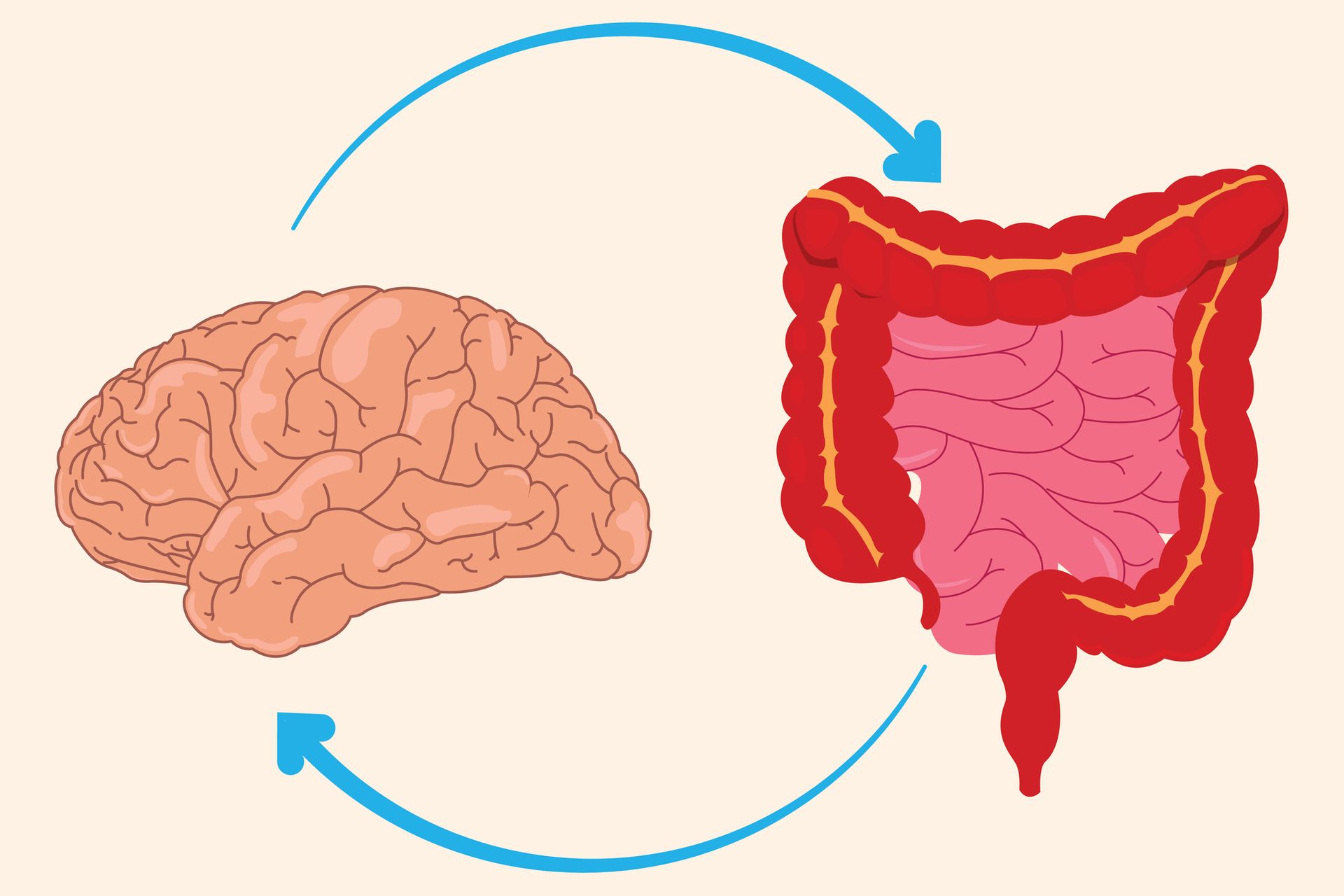Blog

When we think about our mental health, we often focus on our thoughts, emotions, and how we process stress. But did you know that one of the most important factors affecting your mental health might not be in your brain at all? It could be in your gut. The growing field of research around gut health and its influence on mental well-being has opened up new possibilities for how we understand and treat mental health conditions. Let’s dive into why taking care of your gut might be one of the most important things you can do for your mind.

Anxiety can feel like an unwelcome guest in our minds—constant, overwhelming, and often disruptive. Whether it’s work-related stress, social pressures, or personal worries, anxiety can sneak into our lives at any moment, leaving us feeling powerless. But there’s good news: there are practical techniques we can use to manage anxiety and regain control. Here’s a breakdown of some tried-and-true methods that can help you feel more grounded and calm.

Substance abuse is a complex and widespread issue, affecting millions of individuals and their loved ones across the globe. Whether through alcohol, drugs, or other harmful substances, addiction can feel like an unbreakable cycle, but there is hope. One of the most effective tools in breaking that cycle and supporting recovery is substance abuse counseling . In this blog, we’ll explore what substance abuse counseling entails, its importance, and how it can make a profound difference in someone’s journey to sobriety. What is Substance Abuse Counseling? Substance abuse counseling is a therapeutic approach designed to help individuals who struggle with addiction. The goal is to guide people toward understanding their behaviors, uncover the underlying emotional or psychological issues contributing to their addiction, and develop healthier coping mechanisms. Counselors work with clients to set goals, create treatment plans, and provide a supportive environment that fosters recovery. Counseling may take place in individual or group settings, depending on the specific needs of the person seeking help. It often incorporates various therapeutic techniques, including: Cognitive Behavioral Therapy (CBT) : Helps individuals identify and change negative thought patterns that contribute to substance abuse. Motivational Interviewing (MI) : Encourages individuals to explore their reasons for change and helps enhance motivation for recovery. Family Therapy : Addresses the impact of substance abuse on relationships and encourages family members to be part of the healing process. The Importance of Substance Abuse Counseling Addiction is not just a physical dependence on a substance; it’s often tied to deeper emotional, psychological, or social issues. Substance abuse counseling helps individuals confront these issues, making it one of the most powerful tools in recovery. Here's why it matters: Provides a Safe Space for Expression Counseling offers a non-judgmental environment where individuals can openly discuss their struggles. This safe space is crucial for building trust and understanding the root causes of addiction. Whether it’s trauma, mental health issues, or stress, counseling allows individuals to explore these factors and work through them. Personalized Treatment Each person’s journey is unique, and substance abuse counseling tailors treatment plans to fit the individual’s needs. Rather than using a one-size-fits-all approach, counselors assess what works best for each client, adjusting strategies as needed to foster long-term recovery. Building Coping Skills A significant part of recovery involves learning new coping strategies to deal with stress, triggers, and temptations. Counselors teach techniques to help individuals avoid relapse, manage emotional distress, and improve overall well-being. Family Involvement Addiction often impacts more than just the person suffering from it. Substance abuse counseling frequently includes family members in the process, helping them understand the addiction, rebuild trust, and support their loved one’s recovery. Focus on Long-Term Sobriety Substance abuse counseling doesn’t just focus on short-term goals; it’s geared toward helping individuals achieve lasting recovery. The goal is to empower individuals with the tools and skills they need to maintain sobriety over the long term, preventing relapse and ensuring that recovery is sustainable. How Does Substance Abuse Counseling Help? Substance abuse counseling plays a critical role in recovery by addressing the mental, emotional, and physical aspects of addiction. Here’s how counseling specifically supports those seeking sobriety: Healing from Trauma : Many individuals who struggle with addiction have experienced trauma, whether in childhood or adulthood. Counseling allows clients to address these painful memories and begin the healing process, reducing the urge to self-medicate with substances. Understanding Addiction : Addiction can be misunderstood, both by the individual and by those around them. Through counseling, people learn more about the nature of addiction, how it affects the brain, and why it's so difficult to overcome without help. Improving Mental Health : Substance abuse often coexists with mental health disorders such as anxiety, depression, or PTSD. Substance abuse counseling can incorporate treatment for these co-occurring conditions, giving individuals a comprehensive path to healing. Developing Healthy Relationships : Addiction often leads to strained relationships with family, friends, and colleagues. Counseling helps people work on improving their communication skills, rebuilding trust, and fostering healthy, supportive connections. Types of Counseling for Substance Abuse There are various types of counseling options available, including: Individual Counseling : This one-on-one counseling focuses on the personal experiences of the individual, offering a more intimate and tailored approach to their specific needs. Group Counseling : Group therapy involves a group of individuals who are all working through substance abuse. It provides a sense of community and mutual support, as participants can share experiences and strategies. Couples or Family Counseling : Substance abuse affects families, and counseling can help partners or family members understand the addiction, heal together, and build stronger, more supportive relationships. Online Counseling : For those who may not have access to in-person services or prefer remote options, online counseling can provide the flexibility and privacy needed to start recovery from the comfort of one’s own home. The Road to Recovery While the road to recovery from substance abuse can be challenging, it’s important to remember that no one has to walk it alone. Substance abuse counseling is a cornerstone of recovery, providing not only the tools but also the support and compassion needed to rebuild a life free from addiction. If you or someone you know is struggling with substance abuse, reaching out to a counselor is a powerful first step. There’s no shame in seeking help—only strength in taking that step toward healing and lasting recovery.

In today’s fast-paced world, stress has become almost a constant companion for many of us. Whether it’s work deadlines, family responsibilities, or the endless scroll through social media, stress can build up quickly and begin to take a toll on both our mental and physical health. However, managing stress doesn’t have to feel overwhelming. With the right tools and mindset, it’s possible to reduce its impact and regain control. In this blog, we’ll explore practical strategies that can help you manage stress more effectively, allowing you to feel calmer, more focused, and in control. 1. Understand Your Stressors The first step in managing stress is understanding what’s causing it. Take some time to reflect on the situations or people that trigger stress in your life. It might be a specific project at work, conflict in relationships, or financial worries. By identifying these stressors, you can begin to address them more directly. 2. Practice Mindfulness Mindfulness involves focusing on the present moment without judgment. This practice can help you break the cycle of stress by preventing you from overthinking or getting stuck in worry about the future. Meditation, deep breathing exercises, or even mindful walking can reduce stress and help you stay grounded. A simple mindfulness exercise you can try is the “5-4-3-2-1” method. Take a moment to look around and identify: 5 things you can see 4 things you can touch 3 things you can hear 2 things you can smell 1 thing you can taste This exercise helps you reconnect with the present, easing anxiety and promoting a sense of calm. 3. Get Moving Exercise is one of the most effective ways to manage stress. Physical activity releases endorphins, the body’s natural stress relievers. Whether it’s a brisk walk, yoga, dancing, or hitting the gym, regular exercise can help reduce tension, improve mood, and increase your energy levels. Even a short burst of physical activity can provide immediate relief from stress. 4. Prioritize Sleep Lack of sleep can make stress worse, creating a vicious cycle where stress interferes with your ability to sleep, and poor sleep increases stress. To manage stress effectively, prioritize quality sleep. Aim for 7-9 hours of restful sleep per night. Try establishing a calming bedtime routine, such as reading or practicing relaxation techniques, to signal to your body that it’s time to wind down. 5. Set Boundaries One major cause of stress is feeling overwhelmed by commitments. Setting clear boundaries is key to avoiding burnout. Learn to say “no” when necessary, and don’t overcommit yourself. It’s important to recognize your limits and prioritize your well-being. By managing your time effectively and not taking on more than you can handle, you can reduce unnecessary stress. 6. Practice Time Management Feeling stressed because you have too much to do and not enough time can be alleviated through effective time management. Start by organizing tasks in order of importance. Break large tasks into smaller, more manageable chunks, and set realistic deadlines for each. Time-blocking your day can also help you stay focused and avoid the stress of feeling scattered or unprepared. 7. Reach Out for Support You don’t have to handle stress alone. Talking to someone you trust about your challenges can help you feel heard and supported. Sometimes, just verbalizing your concerns can relieve stress and bring clarity. Whether it’s a friend, family member, or therapist, seeking support is an important step in managing stress. 8. Engage in Relaxing Activities Engaging in hobbies or activities that bring you joy can also help reduce stress. Whether it’s painting, reading, cooking, gardening, or simply watching a favorite show, doing something enjoyable gives your mind a break and allows you to recharge. Prioritize time for these activities, even if it’s just for a few minutes each day. 9. Limit Stress-Inducing Substances Certain substances, such as caffeine, alcohol, and nicotine, can exacerbate stress and interfere with relaxation. Try to reduce your consumption of these substances, especially during stressful times. Instead, opt for herbal teas or water, which can promote hydration and help you feel more at ease. 10. Cultivate Gratitude A simple yet powerful way to manage stress is by shifting your focus toward gratitude. When you feel stressed, take a moment to reflect on the things you are grateful for—whether big or small. Keeping a gratitude journal where you jot down positive things each day can help you reframe your mindset and bring more peace into your life. Final Thoughts Stress is a natural part of life, but it doesn’t have to control you. By incorporating these stress management techniques into your daily routine, you can reduce its impact and live a more balanced, fulfilling life. Remember, managing stress is a continuous process, and small changes over time can lead to lasting improvements in your well-being.

Trauma is a powerful experience that can leave long-lasting marks on a person’s mental, emotional, and physical well-being. Whether it’s from a past abusive relationship, a natural disaster, or a car accident, trauma affects everyone differently. For some, it might feel like a constant, overwhelming presence, while for others, it may manifest as sudden flashbacks, anxiety, or even physical pain. Fortunately, therapy has come a long way in helping people heal from the effects of trauma, and one approach that has gained significant recognition is Eye Movement Desensitization and Reprocessing (EMDR) . What is EMDR? EMDR is a type of psychotherapy that was developed by Francine Shapiro in the late 1980s. It was originally designed to treat post-traumatic stress disorder (PTSD), but its use has expanded to help with a variety of trauma-related issues, including anxiety, depression, phobias, and even grief. The therapy involves an eight-phase process that helps clients process distressing memories and reduce their emotional charge. One of the unique aspects of EMDR is its use of bilateral stimulation, typically through eye movements, though taps or sounds can also be used. During EMDR sessions, the therapist guides the client to focus on a traumatic memory while engaging in this form of bilateral stimulation. This process is thought to help the brain reprocess the traumatic memory, shifting it from being a vivid, emotionally charged experience to a neutral memory that no longer causes distress. How Does EMDR Help with Trauma? When someone experiences a traumatic event, the memory of that event can get "stuck" in the brain. This means that the brain doesn't fully process the trauma, and the memory remains vivid, intrusive, and often overwhelming. Individuals who have unresolved trauma might constantly relive the event through flashbacks, nightmares, or feelings of hypervigilance. EMDR helps to reprocess these memories by integrating them into a person's broader life narrative, allowing them to be stored in a more adaptive, less distressing way. The bilateral stimulation that EMDR uses is believed to mimic the natural process the brain goes through during REM (Rapid Eye Movement) sleep, where the brain processes emotions and experiences. By engaging this process in a therapeutic setting, EMDR helps clients process traumatic memories in a way that reduces their emotional intensity and enables healing. The EMDR Process The EMDR approach is broken down into eight phases, each designed to gradually address trauma and help the client move toward healing: History-taking and Treatment Planning : The therapist gathers information about the client’s trauma and determines which memories need to be processed. This phase also involves setting goals for treatment. Preparation : The therapist explains the EMDR process and creates a safe and trusting environment for the client. Coping mechanisms, such as relaxation techniques, are also introduced at this stage. Assessment : The client identifies specific memories or images associated with the trauma and rates their emotional distress. This phase helps pinpoint the focus of the work ahead. Desensitization : During this phase, the client is asked to focus on the traumatic memory while simultaneously engaging in bilateral stimulation. This is the heart of the EMDR process, where the client begins to process and desensitize the traumatic memory. Installation : This phase aims to replace the negative beliefs associated with the trauma (e.g., "I am powerless") with more positive and adaptive beliefs (e.g., "I am in control of my life"). Body Scan : The client is asked to check in with their body to identify any remaining tension or discomfort related to the traumatic memory. Closure : The session ends with the therapist ensuring the client feels grounded and safe. The client is encouraged to use relaxation techniques to manage any residual distress. Reevaluation : In follow-up sessions, the therapist and client assess the progress made, revisiting any remaining unresolved memories or emotions. Why EMDR Works Research has shown that EMDR is highly effective for treating trauma. In fact, the American Psychological Association (APA) and World Health Organization (WHO) recognize it as an evidence-based treatment for PTSD. The effectiveness of EMDR comes from its ability to target the emotional and cognitive aspects of trauma while also utilizing the brain’s natural healing mechanisms. Several studies have found that EMDR can significantly reduce the symptoms of PTSD, often in fewer sessions than traditional talk therapies. A study published in the Journal of Clinical Psychology found that EMDR was effective in reducing PTSD symptoms in veterans, while another study in the Journal of Traumatic Stress highlighted its success in helping survivors of sexual assault. Additionally, EMDR is a highly structured and non-intrusive form of therapy, which means it often feels less overwhelming for clients than other forms of trauma processing. Who Can Benefit from EMDR? While EMDR is most commonly used to treat PTSD, it can also be beneficial for anyone who has experienced trauma or is struggling with related symptoms. Individuals with anxiety, depression, panic attacks, phobias, and grief have all found relief through EMDR. It is also used for those struggling with childhood trauma, relationship issues, or even those simply feeling “stuck” in their emotional healing. Is EMDR Right for Me? Choosing the right therapeutic approach is a deeply personal decision. If you are dealing with unresolved trauma and find that traditional talk therapies haven't worked for you, EMDR might be a great option to consider. It’s important to seek a licensed and experienced EMDR therapist, as the approach requires specific training and expertise. Some people may feel hesitant about the idea of revisiting traumatic memories or using eye movements as part of their therapy, but most clients report feeling a significant sense of relief and empowerment after undergoing EMDR. It’s essential to remember that healing from trauma is not an immediate process and that progress takes time. However, many people find EMDR to be a transformative tool for moving beyond their trauma. Final Thoughts Trauma can feel like an insurmountable burden, but the good news is that it’s possible to heal. EMDR provides a unique and scientifically-backed approach to reprocessing trauma and helping people regain control of their lives. If you’re struggling with trauma, consider reaching out to an EMDR-trained therapist to explore whether this treatment is right for you. Healing is possible, and sometimes the path to healing might be just a few sessions away. Whether you're looking to process past trauma or you're simply curious about new therapeutic methods, EMDR offers a promising pathway toward peace and emotional freedom. Remember, reaching out for help is the first step toward a healthier, happier future.







